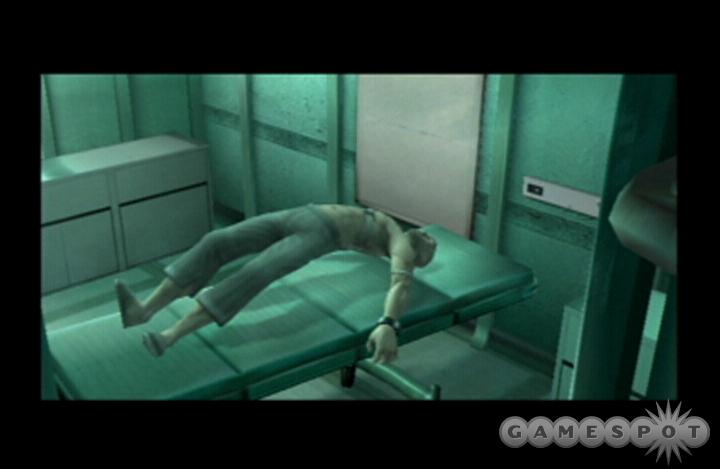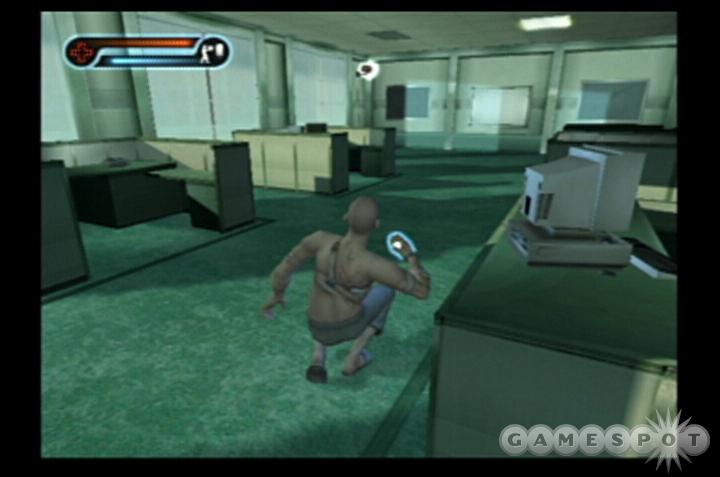Second Sight Hands-On Impressions
We get hands-on with a preview build of Free Radical Design's psychic action adventure game.
We've recently had the opportunity to spend some quality time with preview versions of Second Sight for the PlayStation 2, Xbox, and GameCube. Currently in development at Free Radical Design, the game's visual style will be instantly recognizable to fans of the TimeSplitters series, but its varied and somewhat innovative third-person gameplay is quite different. The versions of Second Sight at our disposal have allowed us to play through the first seven or eight of the game's 17 levels on each platform, and we're pleased to report that we've enjoyed every minute of our time with the game thus far.
In Second Sight, you'll assume the role of Dr. John Vattic, who only knows his own name at the start of the game because it's written on a bracelet he's wearing. Vattic's memory returns as you progress through the game--mostly in the form of playable flashback levels that appear to make up approximately half of the game and which do a great job of drip-feeding you the storyline. At least in the early stages of the game, the flashback and the current-day levels are quite different. In the past, Vattic was essentially a regular guy skilled in the use of firearms and stealth techniques. However, in the present, he not only looks very different after being experimented on in a laboratory but also he boasts a formidable set of psychic abilities, including charm, telekinesis, healing, projection, possession, and a couple of different psi-attacks.
You'll gain access to most of Vattic's psychic abilities as you progress through the game's early levels, and, occasionally, abilities already at your disposal will become more powerful. Telekinesis, for example, is the first ability you'll learn, and it can be used to move practically any inanimate object that you can see. Later in the game, though, you'll also be able to pick up enemies by using the same ability, and, if you want to check out the game's impressive rag-doll physics, you can repeatedly bash them against walls and other objects before tossing them aside. Projection is another of the psychic abilities that becomes more powerful as you progress through the game. It effectively allows you to leave Vattic's corporeal body so that you can assume control of a ghostly form that, although invisible to enemies and closed-circuit television cameras, is able to flick switches. Later in the game, the projection ability can also be used to possess enemies for a short period of time.
Vattic's pool of psychic energy, which appears directly under his health bar, replenishes itself quite quickly whenever you're not using it. In fact, we'd suggest that it replenishes a little too quickly right now, since it's rarely difficult to find someplace to hide when your energy is depleted. Once you've learned the heal and charm abilities (charm makes you invisible to everything but CCTV cameras) the game can occasionally feel a lot less challenging than it should. You'll only be able to use one psychic ability or weapon at a time, by the way, and as you select the one you want (using the directional pad), you'll notice that the game pauses momentarily so that you're not caught with your pants down.

Weapons in the game include pistols, machine guns, assault rifles, tranquilizer guns, and, of course, sniper rifles. You'll be taught how to use weapons and stealth techniques in the game's first flashback level, which sees Vattic reporting to a military training camp. When you draw any of Vattic's weapons, enemies are automatically targeted and can be cycled through by flicking the right analog stick, which is also used for fine-tuning your aim if you're looking for a headshot. Most of the enemy guards and soldiers we encountered took around three shots to kill if they were hit anywhere but the head, and while ammunition is rarely a concern, you'll quickly learn that using anything other than a headshot often results in your target raising the alarm before you finish him or her off. This is especially true when using the tranquilizer gun, which, like its counterpart in Metal Gear Solid 2, is pretty ineffective if you hit anything other than your target's head. Unlike Metal Gear Solid 2, however, tranquilized enemies in Second Sight don't wake up after a period of time. In fact, their bodies disappear into thin air, along with those of enemies that you've killed. Oddly, enemies will often die straightaway if you use telekinesis to hurl an object, such as a crate or a chair, at them.
Despite the fact that you'll invariably be in a position to use your psychic powers or weapons to get through any given situation, stealth is often the best and most satisfying strategy to employ. In addition to the charm ability, Vattic has access to all of the usual stealth techniques, such as backing up against walls, peeking through doors before opening them, and leaning and shooting around corners. It's a little unfortunate, then, that most of the enemies in our version of Second Sight were both shortsighted and not terribly intelligent. Those that move around tend to follow short and predictable routes, while many seem content to just stand in rooms with their backs to the door while waiting for you to grab them from behind (or while waiting for you to line up your headshot). On one occasion, when infiltrating an enemy base in Siberia, we went into a small room that was being patrolled by an enemy soldier. His patrol route didn't allow him to see us walking through the door, and when we accidentally knocked over a number of crates that were stacked in the middle of the room, he didn't even notice. We should point out that the game will feature two different difficulty settings when it ships, so maybe the "challenging" setting will be just that. In our version, though, the normal and challenging options really didn't appear to be any different.

The Siberian base, like most of the locales we visited in Second Sight to date, is quite linear as far as your objectives are concerned. However, it also rewards you with extra weapons and first-aid stations if you take the time to explore. Other memorable locales we visited include a primate research laboratory, an abandoned railway station, and a large asylum--the latter of which was inhabited by some quite amusing patients as well as the requisite security guards and orderlies. One feature that all of the levels we've played have in common is computers that you can interact with. If you have the correct passwords, you'll have no problem getting past the various screensavers and will be able to call up maps of your current location, unlock security doors, look through and deactivate CCTV cameras, read e-mails, and even play simple arcade games if you manage to locate the disks containing them. In one of the levels, we even found an arcade cabinet that allowed us to play a space shooter named Earth Impact. The game is simple, of course, but its details are such that it best demonstrates the level of care and attention that's evident throughout every game released by Free Radical Design.
While the lack of any really intelligent enemies in our version of Second Sight is a little disappointing, we've thoroughly enjoyed our time with the game and are eagerly awaiting a more complete version so that we might see how Vattic's story ends. The only differences we've noticed between the three versions of the game, incidentally, are in the visuals, which are quite significantly better on the Xbox. We'll bring you more information on Second Sight as its September release date closes in.
Got a news tip or want to contact us directly? Email news@gamespot.com
Join the conversation